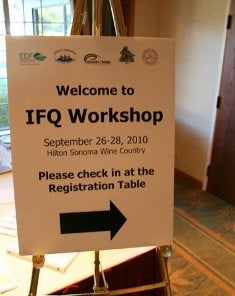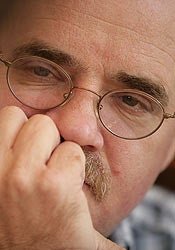
Tom Lalley, EDF Oceans Marketing & Communications Director
An article on SeafoodNews.com highlights cooperation among industry groups to prepare for a switch to catch shares in the West Coast trawl fishery next year. Fishermen, federal government officials, environmentalists, fishery management experts and on-board observer companies – among others – are collaborating to make the transition a success.
Fishing organizations and EDF recently facilitated a workshop in Santa Rosa, CA to share information and tips on a number of topics, like financing and trading quota, fishery mapping and “hotspot management,” cooperative risk pools, increasing revenues, and reducing bycatch. Videos from that event are now available at www.westcoasttrawlers.net. The West Coast Trawlers’ Network is an informal association comprised of the Fisherman’s Marketing Association, Midwater Trawler’s Cooperative, Oregon Trawl Commission, Pacific Whiting Conservation Cooperative and United Catcher Boats.
Full article from SeafoodNews.com posted with permission from John Sackton.
West Coast commercial fishing groups make concerted effort to get ahead of catch share transition
SEAFOOD.COM NEWS by John Sackton – Oct 25, 2010 – IFQ’s are coming to the West Coast groundfishery in 2011, and a coalition of industry associations have been working together to prepare for the upcoming changes.
The West Coast trawlers network consists of the Coos Bay Trawlers Association, the Fishermen’s Marketing Association, the Midwater Trawling Cooperative, the Oregon Trawl Commission, the Pacific Whiting Conservation Cooperative, and United Catcher Boats.
Several of these organizations members have had extensive experience with IFQ programs in Alaska, including how these programs allowed vessels to better manage fleet bycatch, and minimize shutdowns.
Recently the group sponsored a major workshop that was attended by representatives of about half the trawl fleet.
According to Scott Coughlin, a coordinator of the workshop, the group has now posted a series of videos and powerpoints from the workshop on their web site http://www.westcoasttrawlers.net/.
The presentations range from gear and bycatch experts to a representative from Dock street brokers, and cover a range of operational questions involving IFQ programs.
‘The videos present an unusual opportunity to hear from a broad range of experts addressing catch share management of the trawl fishery – a timely topic that affects nearly every West Coast fishing community,’ said Coughlin.














